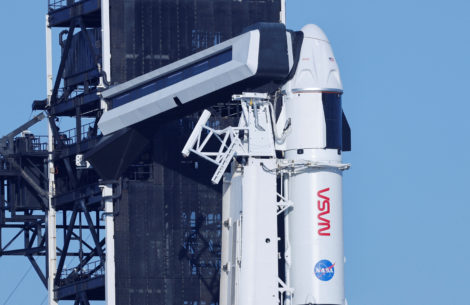SpaceX set to launch next International Space Station crew for NASA

A Falcon 9 rocket is readied before launch on NASA’s SpaceX Crew-6 mission, which will take four crew members to the International Space Station, from the Kennedy Space Center in Cape Canaveral, Florida, U.S., February 26, 2023. REUTERS/Joe Skipper
CAPE CANAVERAL, Florida — Elon Musk’s rocket company SpaceX was set to launch early on Monday the International Space Station’s (ISS) next long-duration team into orbit, with an astronaut from the United Arab Emirates and a Russian cosmonaut joining two NASA crew mates for the flight.
The SpaceX launch vehicle, consisting of a Falcon 9 rocket topped with an autonomously operated Crew Dragon capsule called Endeavour, was set for liftoff at 1:45 a.m. EST (0645 GMT) from NASA’s Kennedy Space Center in Cape Canaveral, Florida.
The four-member crew should reach the ISS about 25 hours later, on Tuesday morning, to begin a six-month mission in microgravity aboard the orbiting laboratory some 250 miles (420 km) above Earth.
Designated Crew 6, the mission marks the sixth long-term ISS team that NASA has flown aboard SpaceX since the private rocket venture founded by Musk – billionaire CEO of electric car maker Tesla and social media platform Twitter – began sending American astronauts to orbit in May 2020.
NASA said the mission’s launch readiness review was completed on Saturday, February 25, and that the flight was given a “go” to proceed to liftoff as planned.
“All systems and weather are looking good for launch,” Musk wrote on Twitter on Sunday.
The latest ISS crew is led by mission commander Stephen Bowen, 59, a onetime U.S. Navy submarine officer who has logged more than 40 days in orbit as a veteran of three space shuttle flights and seven spacewalks.
Fellow NASA astronaut Warren “Woody” Hoburg, 37, an engineer and commercial aviator designated as the Crew 6 pilot, will be making his first spaceflight.
The Crew 6 mission also is notable for its inclusion of UAE astronaut Sultan Alneyadi, 41, only the second person from his country to fly to space and the first to launch from U.S. soil as part of a long-duration space station team. UAE’s first-ever astronaut launched to orbit in 2019 aboard a Russian spacecraft.
Rounding out the four-man Crew 6 is Russian cosmonaut Andrey Fedyaev, 41, who like Alneyadi is an engineer and spaceflight rookie designated as a mission specialist for the team.
Fedyaev is the latest cosmonaut to fly aboard an American spacecraft under a ride-sharing deal signed in July by NASA and the Russian space agency Roscosmos, despite heightened tensions between Washington and Moscow over Russia’s invasion of Ukraine.
The Crew 6 team will be welcomed aboard the space station by seven current ISS occupants – three U.S. NASA crew members, including commander Nicole Aunapu Mann, the first Native American woman to fly to space, along with three Russians and a Japanese astronaut.
The ISS, about the length of a football field and the largest artificial object in space, has been continuously operated by a U.S.-Russian-led consortium that includes Canada, Japan, and 11 European countries.
The outpost was conceived in part as a venture to improve relations between Washington and Moscow following the Soviet Union’s collapse and the end of Cold War rivalries that gave rise to the original U.S.-Soviet space race in the 1950s and 1960s.
NASA-Roscosmos cooperation has been tested as never before since Russia invaded Ukraine a year ago, leading the United States to impose sweeping sanctions against Moscow while steadily increasing military aid to the Ukrainian government.
The Crew 6 mission also follows two recent mishaps in which Russian spacecraft docked to the orbiting laboratory sprang coolant leaks apparently caused micrometeoroids, tiny grains of space rock, streaking through space and striking the craft at high velocity.
One of the affected Russian vehicles was a Soyuz crew capsule that had carried two cosmonauts and an astronaut to the space station in September for a six-month mission now set to end in March. An empty replacement Soyuz to bring them home blasted off on Friday and arrived at the space station on Saturday.
RELATED STORIES
Four-member SpaceX crew safely docks with space station
SpaceX set to launch space station’s next astronaut crew for Nasa